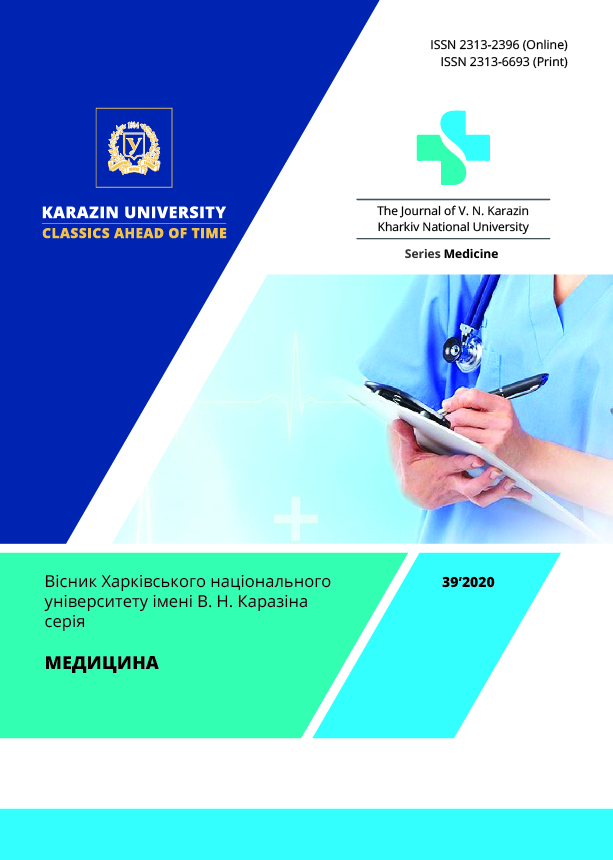Analysis of frequency and structure of indications to cesarean section by M.S. ROBSON criteria
Abstract
Annotation. In 2001, M. S. Robson proposed a classification based on criteria to identify pregnant women whose birth is not possible naturally. The purpose of the study is to analyze the frequency and structure of indications for caesarean section to determine promising ways to optimize the management of labor.
Materials and methods. Based on the final diagnoses, an analysis of the structure of the absolute and percentage number of women groups M.S. Robson, the caesarean section frequency in each group, and the caesarean section structure for individual groups in 2071 women giving birth in the Kharkov city perinatal center, including 726 (35,1 %), by caesarean section.
Results. The most promising in terms of reducing the frequency of cesarean section are women of the 1st, 2d and 3rd groups. In most cases, caesarean section in these groups was performed due to complications of childbirth or in connection with obtaining new data on the risk of complications during childbirth. Among these women, a rather frequent indication for emergency surgery is primary weakness of labor (in the 1st and 3rd groups) or weakness of labor after unsuccessful induction of labor (2a and much less often – 4a group). It is this contingent of pregnant women and women in childbirth that requires special attention. On the one hand, it is a reserve to reduce the frequency of cesarean section, on the other hand, in some cases, the operation is performed late, which leads to severe depletion of the woman in labor during childbirth, complete suppression of the contractile function of the uterus with a lack of sensitivity to oxytocin and to severe hypoxic-ischemic complications in the fetus.
Conclusions. To substantiate a decrease in the frequency of cesarean section, the most promising is the group of women with first or repeated births with full-term single-term pregnancy and head presentation of the fetus (groups 1 and 3 according to M.S. Robson), and with planned induction of labor (groups 2a and 4a), that make up more than 20 % of women after cesarean section. Planning the optimal tactics of labor management for these women on the basis of identifying risk factors and determining the contingent of women for whom a set of preventive and therapeutic measures is appropriate is to reduce the frequency of cesarean section.
Downloads
References
Guriev, D. L., Okhapkin, M. B., Gurieva, M. S., Kabanov, I. V., Gurieva, D. D., Asadova, S. A. (2019). Using the Robson Classification to Reduce Rates of Cesarean Section and Perinatal Loss in a 3A-Level Hospital. Doctor.Ru, 4 (159), 8–13. DOI: 10.31550/1727-2378-2019-159-4-8-13
Moskviak-Lesniak, D. Y., Krasivska, A. V., & Zhygaliak, I. T. (2019). Research of the Factors Which Increase Level of Caesarian Section in 2017–2018. Bulletin of Social Hygiene and Health Protection Organization of Ukraine, 3, 25–29. DOI: 10.11603/1681-2786.2019.3.10587
Ferreira, E. C., Pacagnella, R. C., Costa, M. L., Cecatti, J. G. (2015). The Robson ten-group classification system for appraising deliveries at a tertiary referral hospital in Brazil. Іnt J Gynaecol Obstet, № 129 (3), 236–239. DOI: 10.1016/j.ijgo.2014.11.026
Martin, J. A., Hamilton, B. E., Osterman, M. J. K. (2017). Births in the United States, 2016. NCHS Data Brief, № 287, 1–8. Available on: https://www.cdc.gov/nchs/data/databriefs/db287.pdf
Li H.-T., Luo S., Trasande L., et al. (2017). Geographic variations and temporal trends in cesarean delivery rates in China, 2008–2014. JAMA, 317, 69–67. DOI: 10.1001/jama.2016.18663
Robson Classification: Implementation Manual. WHO, 2017. 52 р. Available on: https://www.who.int/reproductivehealth/publications/maternal_perinatal_health/robson-classification/en/
Caughey, A. B, Cahill, A. G, Guise, J. M, Rouse, D. J. (2014). Safe prevention of the primary cesarean delivery. American College of Obstetricians and Gynecologists (College); Society for Maternal-Fetal Medicine, Am J Obstet Gynecol, 210 (3), 179–193. DOI: 10.1016/j.ajog.2014.01.026
WHO statement on caesarean section rates. World Health Organization Human Reproduction Programme, 10 April 2015. 149–150. DOI: 10.1016/j.rhm.2015.07.007
The Journal of V. N. Karazin Kharkiv National University, series Medicine has following copyright terms:
- Authors retain copyright and grant the journal right of first publication with the work simultaneously licensed under a Creative Commons Attribution License that allows others to share the work with an acknowledgement of the work’s authorship and initial publication in this journal.
- Authors are able to enter into separate, additional contractual arrangements for the non-exclusive distribution of the journal’s published version of the work, with an acknowledgement of its initial publication in this journal.
- Authors are permitted and encouraged to post their work online prior to and during the submission process, as it can lead to productive exchanges, as well as earlier and greater citation of published work.




